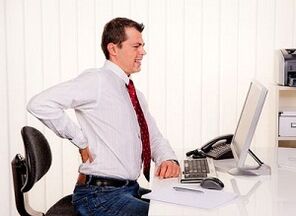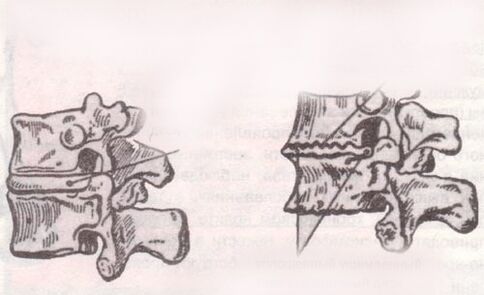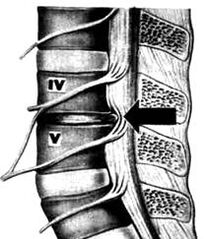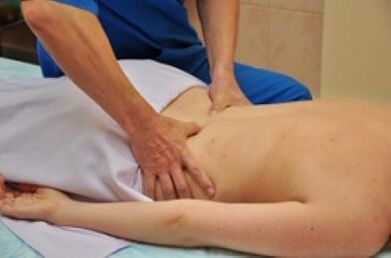The osteochondrosis of the lumbosacra column is a distribution spinal disease, in which the normal structure of the entire spinal column and the particular intervertebral discs is gradually destroyed.It should be said that not only the back suffers, but the entire organism, especially the pelvic organs and the lower extremities.

The reasons for development
The lumbar region for the life of a person in relation to a frankness experiences a colossal vertical load that cannot completely compensate even the large size of the vertebrae.Therefore, the slightest changes in the human body, a decrease in the muscle corset of the low back, excess weight, injuries, incorrect movements and much more can lead to the development of the disease.In addition, you should always remember about age -related changes in the spine regarding each person.

When summarizing the above, the most frequent risk factors can be distinguished, whose totality leads to the osteochondrosis of the lumbar:
- Unequal and irregular loads in the column (severity of lifting from an inclined position, etc.).
- Excess weight (almost every kilogram is important).
- Rumor injuries, including sports.
- Weakening of muscle corset (prolonged work in a monotonous position, etc.).
- Infuted diet, poor in minerals and vitamins.
Symptoms
The symptoms of the disease may vary a lot, however, all the main signs of osteochondrosis develop, as a rule, in three syndrome:
- Verobroogenic low back pain (synonym for lumbago).
- VERTI -LUMBOYSHALGIA LUMBOBON.
- Ischialgia Vartro -Carbono (inflammation of the sciatic nerve).
However, in addition to pain in the lumbar region (with irradiation in the legs, buttocks and inguinal areas of or without such), the tension of the lower back muscles, the weakness in the legs, the crunch during the lower back movements and the difficulties of the movements in the lumbar region must be distinguished by an amount of other important symptoms of ostebondrosis of the lumbar: lumbar: lumbar: lumbar: lumbar: lumbar: lumbar: lumbar: lumbar: lumbar: lumbar: lumbar: lumbar: lumbar: lumbar: lumbar: lumbar: lumbar: lumbar: lumbar: lumbar: lumbar: lumbar: lumbar
- Numbness on the legs and a feeling of spending chicken skin on the legs.
- Leg cramps.
- Pelvic disorders (delay or incontinence of urine, constipation or diarrhea).
- Weakness in certain groups of the leg muscles.
These complaints can guide the neurologist at the level of damage to the spine, make a differential diagnosis with other spine diseases.
Diagnosis and signs x -Rayos

Osteochondrosis must be diagnosed with only one type of instrumental methods: radiological.Visualizing the complete structure of the spine in modern medicine allows the best study of MSCT or MRI, however, simple radiography has not lost its estimated value (as a detection study).It is important to remember that the main stage in the diagnosis of column problems will be a medical examination, which sometimes allows you to make a diagnosis without an exam.
In the neurological status, Pain is detected on palpation of the Spicy Process of Vartebrae, Tension of the Lower Back Muscles, and If there is only osteochondrosis, The There Should Be No Symptoms Such As: Dentased Tendon TenOF COMPRESSION OF THE SPINAL CORD ROOTS), IMPAIRED MUSCLE AND MUSCLE OF THE LISS, WEAKNESS OF MOVEMENT OF MOVEMENT OF MOUTION IN THE LEGS.In the presence of these symptoms, differential diagnoses with disk hernia and other more serious diseases of the spine should be carried out.
Treatment
The treatment of the disease implies a full therapy.The instructions in the treatment of several - elimination of exacerbation medications, auxiliary methods not funds, as well as the preventive method of physiotherapy exercises, partially used in the acute period, and does not lose its relevance to today.
medicine
It is a combination of myorlaxing therapy, anti -inflammatory pathogenetic therapy, as well as the use of neuroprotective drugs.The choice of drugs and dosing calculations come from the weight of a person, gender, the presence of concomitant diseases.
In the acute period, it is advisable to inject medicines such as diclofenac, Meloxicam.In addition, in parallel, they begin to carry out the therapy for the elimination of muscle spasm and the protection of the nerve fiber of the damage.
Without a flutist

It is represented by physioce and manual influences.Given the massiveness of muscle groups, a fairly extensive level of the anatomical zone, physiotization can only be an auxiliary method.DDT, electrophoresis, magnetotherapy, which allow it to improve the effect of medications are used.
However, massage and manual therapy can sometimes stop the symptoms of lumbar osteochondrosis even without support for medications.This is due to the fact that muscle spasm can be eliminated quite well, and pain is not always caused by the inflammatory process, sometimes only careless movement leads to pain, whose consequences are effectively eliminated in the early hours after pain development.
Gymnastics for the osteochondrosis of the lumbar region aims to stretch the back muscles and strengthen them.In the presence of the established diagnosis, lumbar osteochondrosis must participate daily in physiotherapy exercises.Subject to general rules (restriction of excessive physical activity, hypothermia), body weight control and exercise for the osteochondrosis of the lumbar region on the disease can sometimes be forgotten for many years.
























